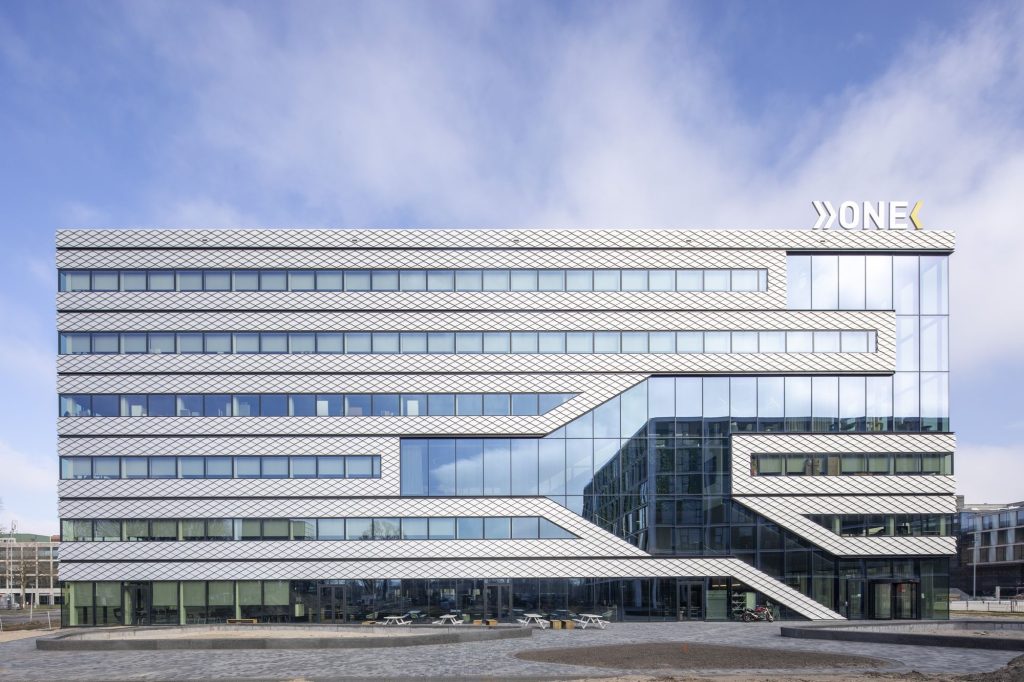
MVRDV . photos: © Daria Scagliola
The construction of Matrix ONE, the MVRDV-designed laboratory and office building in the heart of Amsterdam Science Park, is now complete. Serving as the main hub of the Matrix Innovation Center, the six-story, 13,000-square-metre building provides the campus with key social spaces and amenities. Crucially, the project also pushes the envelope in sustainable design: from demountable construction, the “social stairs”, and solar energy generation to smart lighting and generous amounts of bicycle parking, it incorporates sustainable thinking from every possible angle. Matrix ONE meets ambitious Amsterdam energy-use targets and is certified BREAAM- Excellent. The building’s users are also working on sustainability solutions: the University of Amsterdam’s SustainaLab works here on technologies for a sustainable future.
Matrix ONE is the largest of seven buildings that now make up the Matrix Innovation Center, part of Amsterdam Science Park, where scientists and entrepreneurs work on sustainable solutions for current and future problems. Matrix ONE itself contains a mixture of science laboratories and offices for tech companies including Qualcomm and sustainability companies such as Photanol, Skytree, and the startup FUL Foods.
As the main building of the Matrix Innovation Center, Matrix ONE aims to be a sustainable example for the other buildings in Amsterdam Science Park and beyond. The building is designed to be demountable. Simple connections such as screws and bolts allow elements to be detached and reused when various parts of the building are updated; even the building’s floors are made using prefabricated concrete slabs with no fixed connections, allowing them to be reused at the end of the building’s lifespan. The platform Madaster provides a comprehensive material passport system to give insight into the materials and products used and the CO2 storage for over 120,000 individual components. As a result, over 90% of the building’s materials can be reused again later.
On the roof, 1,000 square meters of solar panels generate a portion of the building’s energy, while internet-connected lighting and heating fixtures help to reduce energy consumption (power for critical lab equipment runs on a separate circuit). With this combination of energy generation and reduced energy consumption, the building itself produces a significant proportion of the energy it consumes and therefore meets the ambitious Amsterdam targets for energy performance.
As the main building of the Matrix Innovation Center, Matrix ONE serves as the social hub of the campus. A key element of MVRDV’s design is the large “social staircase” immediately next to the main entrance on the building’s southern corner, which is conceptualized as a continuation of the zig-zagging paths that are found throughout the campus. With tribune-style seating for presentations, tables for informal meetings, and coffee stations, these stairs bring together workers from different industries, allowing them to mingle and share ideas. The interior design for this space, developed by MVRDV in collaboration with Up architecture, includes multiple lush green walls that are visible through the glass façade, while soft felt finishes elsewhere dramatically reduce sound reverberation, lending the social spaces a calm and intimate atmosphere.
This social staircase is complemented by the building’s amenities, with a ground-floor restaurant and a bar at the top of the staircase. These social features form “Club Matrix”, available for use by workers from all of the surrounding Matrix buildings. The building also includes a 100-seat auditorium, confirming Matrix ONE as a central hub for creating and sharing knowledge.
Matrix ONE also encourages users to lead a healthy lifestyle: the location of the social stair encourages people to use the stairs instead of the elevators, which are found deeper inside the building, accessed via the atrium. On the rear of the building, a secondary entrance includes access to a bicycle parking facility that is directly accessible and visible from the atrium, encouraging those who work in the building to cycle instead of driving. As a result of all of these sustainability and health measures, the building has received BREEAM-Excellent certification.
_






























